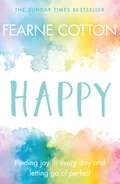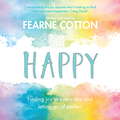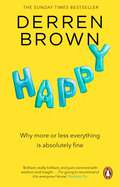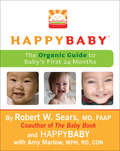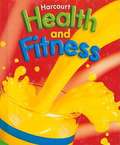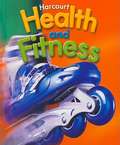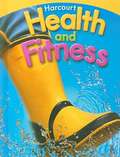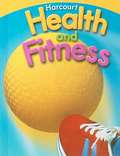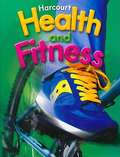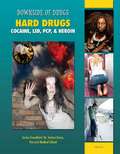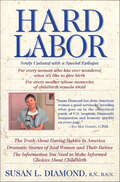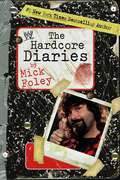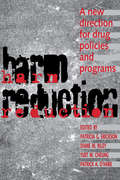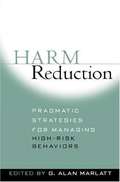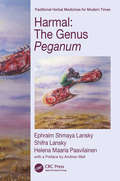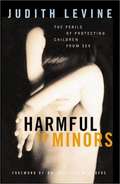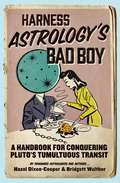- Table View
- List View
Happy: A Beginner's Book of Mindfulness
by Nicola EdwardsA perfect bedtime read, this picture book gently encourages children to explore the senses and discover their path to mindfulness."Mindfulness is all about connetion with ourselves and the world around us."This poetically-written introduction to mindfulness touches upon the most important aspects of life--feeling, discovering, smelling, listening, and all the things that bring the world to life. With every soothing read and practice, children are better equipped to understand and control their own emotions...and diiscover an appreciation for the beautiful world around them.
Happy: Finding joy in every day and letting go of perfect
by Fearne Cotton'Wonderfully honest and relatable, and it's also extremely comforting and reassuring too' MIND, No.1 Mental Health charity'I recommend this for anyone who's looking to find true consistent happiness' Craig David"This book is a way to release what's going on inside your head and to keep heading towards the good stuff. The simple stuff. The stuff that's going to really hit up that happiness on a deep and nourishing level. Whether you dip into these pages every now and then when you feel you need it, or use it daily as a positive exercise, I hope it brings you much relief, joy and calm. Amen to the pen." - Fearne Cotton For many of us, life can feel like it's moving too fast with pressure bearing down on us from all sides - whether that's from school or work, family or social media. As a result, we find ourselves frazzled, lost and - too often - feeling blue.It's a subject close to Fearne's heart. Drawing on her own experiences and including expert advice, HAPPY offers practical ways of finding joy each and every day. Happiness isn't a mountain to climb, it's just one foot in front of the other on the path of life, and here you'll find little steps that will help make the differences that count. With workbook elements to help you start and end the day well; get in touch with your creative side; and find peace through written exercises, simple practical ideas and visualisations, these are daily tricks and reminders to help you unlock that inner happiness.
Happy: Finding joy in every day and letting go of perfect
by Fearne Cotton'Wonderfully honest and relatable, and it's also extremely comforting and reassuring too' MIND, No.1 Mental Health charity'I recommend this for anyone who's looking to find true consistent happiness' Craig David"This book is a way to release what's going on inside your head and to keep heading towards the good stuff. The simple stuff. The stuff that's going to really hit up that happiness on a deep and nourishing level. Whether you dip into these pages every now and then when you feel you need it, or use it daily as a positive exercise, I hope it brings you much relief, joy and calm. Amen to the pen." - Fearne Cotton For many of us, life can feel like it's moving too fast with pressure bearing down on us from all sides - whether that's from school or work, family or social media. As a result, we find ourselves frazzled, lost and - too often - feeling blue.It's a subject close to Fearne's heart. Drawing on her own experiences and including expert advice, HAPPY offers practical ways of finding joy each and every day. Happiness isn't a mountain to climb, it's just one foot in front of the other on the path of life, and here you'll find little steps that will help make the differences that count. With workbook elements to help you start and end the day well; get in touch with your creative side; and find peace through written exercises, simple practical ideas and visualisations, these are daily tricks and reminders to help you unlock that inner happiness.
Happy: Finding joy in every day and letting go of perfect
by Fearne Cotton'Wonderfully honest and relatable, and it's also extremely comforting and reassuring too' MIND, No.1 Mental Health charity'I recommend this for anyone who's looking to find true consistent happiness' Craig David"This book is a way to release what's going on inside your head and to keep heading towards the good stuff. The simple stuff. The stuff that's going to really hit up that happiness on a deep and nourishing level. Whether you dip into these pages every now and then when you feel you need it, or use it daily as a positive exercise, I hope it brings you much relief, joy and calm. Amen to the pen." - Fearne Cotton For many of us, life can feel like it's moving too fast with pressure bearing down on us from all sides - whether that's from school or work, family or social media. As a result, we find ourselves frazzled, lost and - too often - feeling blue.It's a subject close to Fearne's heart. Drawing on her own experiences and including expert advice, HAPPY offers practical ways of finding joy each and every day. Happiness isn't a mountain to climb, it's just one foot in front of the other on the path of life, and here you'll find little steps that will help make the differences that count. With workbook elements to help you start and end the day well; get in touch with your creative side; and find peace through written exercises, simple practical ideas and visualisations, these are daily tricks and reminders to help you unlock that inner happiness.Written and read by Fearne Cotton(p) 2017 Orion Publishing Group
Happy: Why More or Less Everything is Absolutely Fine
by Derren BrownThe Sunday Times Bestseller'Really brilliant and just crammed with wisdom and insight. It will genuinely make a difference to me and the way I think about myself.' Stephen Fry___Everyone says they want to be happy. But that's much more easily said than done. What does being happy actually mean? And how do you even know when you feel it?In Happy Derren Brown explores changing concepts of happiness - from the surprisingly modern wisdom of the Stoics and Epicureans in classical times right up until today, when the self-help industry has attempted to claim happiness as its own. He shows how many of self-help's suggested routes to happiness and success - such as positive thinking, self-belief and setting goals - can be disastrous to follow and, indeed, actually cause anxiety.Happy aims to reclaim happiness and to enable us to appreciate the good things in life, in all their transient glory. By taking control of the stories we tell ourselves, by remembering that 'everything's fine' even when it might not feel that way, we can allow ourselves to flourish and to live more happily.___What readers are saying: ***** 'Immensely positive and life-affirming'***** 'This is the blue print to a good life'***** 'Thought provoking and potentially life-changing.'
HappyBaby
by Robert W. SearsA healthy baby is a HAPPYBABY! From the most respected names in parenting come this definitive book on child rearing the all-natural way. HappyBaby combines decades of medical expertise from Dr. Robert W. Sears, renowned doctor in the Sears family of pediatricians, with the nutritional know-how of Amy Marlow, registered dietitian for the popular HAPPYBABY line of organic baby food. Look no further than between the pages of this jam-packed guide to find answers to critically important questions in the life of your baby, such as: What should I eat when nursing my baby to ensure the most nutritional feedings? What simple tips can help me manage the inevitable stress that comes with a new baby in the house? I'm worried about toxins in my baby's nursery. How can I green the new room? When do I introduce my child to solid foods, and how can I do it in a safe and fun way? How can I develop healthy eating habits in my children? This groundbreaking book offers a proactive, harmonious approach to parenting that's easier, greener, and just plain better for your precious infant or toddler.
HappyBaby
by Robert W. SearsA healthy baby is a HAPPYBABY!From the most respected names in parenting come this definitive book on child rearing the all-natural way. HappyBaby combines decades of medical expertise from Dr. Robert W. Sears, renowned doctor in the Sears family of pediatricians, with the nutritional know-how of Amy Marlow, registered dietitian for the popular HAPPYBABY line of organic baby food. Look no further than between the pages of this jam-packed guide to find answers to critically important questions in the life of your baby, such as:What should I eat when nursing my baby to ensure the most nutritional feedings?What simple tips can help me manage the inevitable stress that comes with a new baby in the house?I'm worried about toxins in my baby's nursery. How can I green the new room?When do I introduce my child to solid foods, and how can I do it in a safe and fun way?How can I develop healthy eating habits in my children?This groundbreaking book offers a proactive, harmonious approach to parenting that's easier, greener, and just plain better for your precious infant or toddler.
Harcourt Health and Fitness
by Lisa Bunting Thomas M. Fleming Charlie Gibbons Jan Marie Ozias Carl Anthony StocktonA textbook for children on health and fitness.
Harcourt Health and Fitness
by Lisa Bunting Thomas M. Fleming Charlie Gibbons Jan Marie Ozias Carl Anthony StocktonA book designed to help students develop positive behaviors and attitudes that lead to a lifetime of good health.
Harcourt Health and Fitness
by Lisa Bunting Thomas M. Fleming Charlie GibbonsNIMAC-sourced textbook
Harcourt Health and Fitness
by Harcourt School Publishers StaffThis book contains chapters on: Your Amazing Body, Taking Care of Yourself, Food for a Healthy Body, Activity for a Healthy Body, Keeping Safe, Emergency Safety, Preventing Disease, Medicines and Other Drugs, Avoiding Tobacco and Alcohol, About Yourself and Others, Your Family and You, and Health in the Community.
Harcourt Health and Fitness (Grade #2)
by Harcourt School PublishersThe perfect guide to help someone to stay healthy and fit, for 2nd graders.
Harcourt Health and Fitness (Grade #4)
by Harcourt School PublishersYou can do many things to help yourself stay healthy and fit. Just as importantly, you can avoid doing things that will harm you. If you know ways to stay safe and healthy and do these things, you can help yourself have good health throughout your life.
Hard Drugs: Cocaine, LSD, PCP, & Heroin
by Celicia ScottHard drugs like cocaine, heroin, LSD, and PCP can hurt your body and change the way your mind works. And it only takes trying these drugs once to put you at risk. Discover the true consequences of using the world's most dangerous drugs. Learn how hard drugs damage your mind and body, and how they can get you in trouble with the law. Find out about the downside of hard drugs!
Hard Hit
by Ann Warren TurnerIn this latest work from the author of the groundbreaking memoir "Learning to Swim," 16-year-old high school baseball star Mark has an enviable life. However, when his father is diagnosed with cancer, everything Mark ever believed in is called into question.
Hard Labor
by Susan L. DiamondAn obstetrical nurse who spent nearly a decade working on labor and delivery wards, a prepared childbirth instructor, a mother of two, and now a registered doula (a type of birth attendant), Susan L. Diamond has an unmatched perspective on the impact of modern medicine on the process of birth. In Hard Labor, readers learn that women in labor are routinely dehumanized by artificially established "labor curves" and confined by often unnecessary machinery. Diamond's vision is of childbirth as a natural, normal event which should be enhanced by modern medicine.Hard Labor introduces readers to dozens of mothers, fathers, and families, and reveals the triumphs and tragedies that fill labor and delivery wards. From the sadness of death in utero to the joy of unexpectedly delivering twins, Hard Labor is a moving reading experience.For this edition, Diamond has added a section on how she left "organized" medicine to take her message directly to women, and on her recent work as a certified doula.At the Publisher's request, this title is being sold without Digital Rights Management Software (DRM) applied.
Hard Talk: When Speech Is Difficult
by Jonathan ColeA moving, patient-centered portrait of the social importance of speech, from a medical expert known for his humanizing explorations of health.Language comes to us through culture, environment, and family. Words embed over time, as we use our minds to comprehend them and then our mouths to say, mean, and own them. Without the ability to speak, or when talking becomes difficult, we face a challenge like few others, forced to reconnect with a world that assumes its communicators are eloquent vocally. In Hard Talk, Jonathan Cole takes a necessary look at the privilege of speech so we can better accommodate those for whom it presents problems. Cole creates space for people with a variety of conditions, including cerebral palsy, vocal cord palsy, cleft palate, Parkinson&’s, and post-stroke aphasia, to describe in their own words what the experience of difficult speech is like. No struggle is the same. Each develops along its own axis of factors—cognitive, social, and physical—that lead to unique vulnerabilities as well as extraordinary moments of adaptation and resilience. One person finds social chatter becoming more problematic than work speech. Another grows alarmed as changes in speech begin to constrain inner thoughts. Some lose the ability to find or make words though they retain awareness, while others lose self-awareness but maintain fluent speech bereft of meaning. One even loses the ability to speak with family while continuing to interact at work.Hard Talk reacquaints us with the social power of speech while affirming the humane value of listening. Cole also reflects on the neuroscientific advances we&’ve made in understanding barriers to speech and how we might reduce them.
Hardcore Diaries (WWE)
by Mick FoleyThe New York Times bestselling author Mick Foley returns to his fans favorite subject: Mick Foley and wrestling!What was I thinking? Another autobiography? A third? Who did I think I was, Winston Churchill? Why would I want to set my pen loose on hundreds of sheets of notebook paper unless I really felt I had something worth writing about? Besides, I had a wrestling comeback to prepare for, mentally and physically, provided I could get Vince McMahon and the WWE creative staff to embrace what I was sure was the single greatest storyline of my career. Then it hit me: the storyline. I would give WWE fans unprecedented access to World Wrestling Entertainment, covering everything from conception to completion. I would recount how I felt about specific interviews and matches, whether they helped or hurt. I would expose the backstage politics, shed some light on my rocky relationship with Vince McMahon, offer insights into my personal dealings with WWE Superstars, and tell stories about my favorite Divas. But I wasn't interested in writing just a wrestling book. I wanted to share moments from my personal life as well, from a humorous look at my unlikely dinner with polarizing neocon Paul Wolfowitz, to my haunting meeting with a severely burned boy in Afghanistan, to my peculiar obsession with a certain jolly old elf. I knew I could make the fans care about this storyline, provided I could once again find the passion to make the story come to life in arenas around the country and on television sets around the world. Most importantly, I had to ask myself a vital question, one upon which this whole idea, and therefore the book you hold, hinges: Was I willing to become the first voluntary member of the Vince McMahon "Kiss My Ass Club"? I sat on the idea for a few days, to let the idea ripen and mature in my mind, like a fine vintage wine, and to figure out if I was really willing to kiss his ass. I mean, literally kiss a man's ass. Sure, I'd been kissing the same guy's ass figuratively for a decade. But this was different. Did I really have the testicular fortitude required for such a task? In front of millions? Including my wife and kids? I made the call.
Harm Reduction
by Patricia G. Erickson Diane M. Riley Yuet W. Cheung Pat A. O'HareSince the First International Conference on the Reduction of Drug-Related Harm, held in 1990, the term 'harm reduction' has gained wide currency in the areas of public health and drug policy. Previously the field was characterized by heated struggle between prohibition and legalization of addictive substances, and this debate tended to obscure practical, collective approaches. Harm reduction, an approach which encompasses various policy directives and program initiatives was inspired by the positive outcomes of such public measures as needle-exchange programs for reduction of HIV risk, methadone maintenance programs, education on the risks of tobacco use, and programs designed to limit alcohol consumption.The essays in this book illustrate the scope and vigour of the emerging harm reduction model. The essays, drawn from seven international conferences on harm reduction, cover a wide variety of topics, including public policy, women and reproductive issues, the experiences of special populations, human rights; defining and measuring harm, and intervention.Researchers and practitioners will benefit from the varied papers in the volume, which combine insights into policy-making and front-line outreach efforts with comprehensive conceptual and empirical approaches. Harm Reduction represents an important initiative in making academic work accessible and useful to a larger community, and provides guidance for the development of effective policies and programs.
Harm Reduction: Pragmatic Strategies for Managing High-Risk Behaviors
by G. Alan MarlattHarm reduction principles and strategies are designed to minimize the destructive consequences of illicit drug use and other behaviors that may pose serious health risks. The first major harm reduction text, this provocative and timely volume examines a wide range of current applications, from needle exchange and methadone maintenance programs, to alternative alcohol interventions and HIV/AIDS prevention campaigns. Insight is also offered into the often contentious philosophical and policy-related debates surrounding this growing movement.
Harmal: The Genus Peganum (Traditional Herbal Medicines for Modern Times)
by Ephraim Shmaya Lansky Shifra Lansky Helena Maaria PaavilainenHarmal: The Genus Peganum is an in-depth treatment of one of the most commanding plants in the botanical kingdom. Humble in appearance, modest in its needs, Peganum harmala has been venerated for millennia as a Deity-manifesting entheogen and a powerful medicine. This book traverses harmal’s medicinal chemistry, its possible role in the origins of religion, and its employment from ancient times to the present in the therapy of patients suffering from infections, infestations, metabolic derangements, neurological degeneration, visual weakness, and cancer. Its peculiar indolic compounds, known as harmala alkaloids, are now appreciated as exerting profound effects on the mind and on the body. These effects are the result of the alkaloids’ interactions with, and binding to, serotonin receptors on the cell surfaces of neurons in the brain and lymphocytes in the blood, the latter constituting the diffuse structural basis of the immune system. This biphasic modulation by harmala alkaloids has led to a novel pharmacologic re-visioning presented herein for the first time, the concept of a "lymphoneuric syncytium" and its possible long term tuning via "somatodelic" as well as "psychedelic" effects. The scientific rationale underlying the use of harmal in the medicines of the past and the healing technologies of our future is developed through exhaustive and meticulous explorations in both ethnopharmacology and modern phytochemistry. The presentation is enhanced through appraisals of the effects of harmal in two clinical cancer case scenarios, and of intentional inebriation and "provings" by one of the authors and a psychiatric colleague. The noted and esteemed botanically-trained physician Dr. Andrew Weil states in his Preface that this "monumental" volume will become the standard reference work in the field. Harmal: The Genus Peganum will be an invaluable addition to the personal libraries of professional pharmacognosists, botanists, physicians, psychologists, neuroscientists, and all persons interested in the interrelationship of consciousness, medicine, and coevolution.
Harmful to Minors: The Perils of Protecting Children from Sex
by Judith LevineDiscusses the problems that arise when children's access to information about sex is restricted
Harmonic Healing: 6 Weeks to Restored Energy, Complete Detoxification and Total Wellness
by Dr. Linda LancasterFor four decades, Dr Linda Lancaster's healing knowledge has been available only to her star-studded client list, including Mamma Mia's Amanda Seyfried. In Harmonic Healing, her first book, she shares her lifetime of knowledge with readers for the first time.In this book, she introduces readers to what she likes to call 'The Invisible Within the Visible', the energetic roots of ill health - caused by toxins, radiations, shock and stress - and how these invisible attacks on the energetic level manifest in the physical, starting in the liver. She also offers a comprehensive, doable and affordable programme to help readers rebalance their health and achieve a state of comprehensive wellbeing.Dr Lancaster's six-week programme is based on natural ingredients and non-chemical processes, requiring no expensive supplements. Readers will learn how to remove energetic interferences and reclaim their health through positive lifestyle changes, including cleansing foods, detoxifying baths and homeopathic remedies.Harmonic Healing is co-written with Amely Greeven, New York Times bestselling co-writer of Clean by Dr Alejandro Junger, Primal Fat Burner by Nora Gedgaudas, and Dr Frank Lipman's forthcoming book.
Harmonic Healing: Restore Your Vital Force for Lifelong Wellness
by Linda LancasterWe live in an age of unprecedented flourishing of technology in medicine. So why are we experiencing such epidemic levels of pain, disease, emotional and mental stress, and just plain old poor health—and often at such uncommonly young ages? Searching to answer these questions, we turn to every possible medical specialty and lifestyle cause, looking for clues. After guiding thousands of patients on their journeys back to health, Dr. Linda Lancaster has discovered that it is the interplay of invisible forces such as chemicals, heavy metals, radiation, and opportunistic parasites--the “Five Culprits”--worms, fungus, bacteria, micro-parasites, and viruses, that are the cause of many of the health struggles we experience today. This fundamental dynamic is the origin of most of the symptoms she has seen, including chronic exhaustion, digestive distress, painful joints, infertility, eczema, and mysterious conditions like Lyme Syndrome. If you have experienced any of these symptoms, you know how the physical experience affects your emotional wellbeing. But it doesn’t have to be that way. You can begin to take your life back with Harmonic Healing. In this six-week foundational program, you will learn how to cleanse your liver, neutralize environmental pollution, revitalize your energy and return to a balanced state of health, using solely nontoxic, inexpensive, and natural protocols. With nourishing recipes, therapeutic baths, and gentle homeopathic and household remedies, Harmonic Healing helps clear the path for your journey back to health and well-being.
Harness Astrology's Bad Boy
by Hazel Dixon-Cooper Bridgett WaltherDon't let your life be bullied by Pluto. Discover how to domesticate astrology's bad boy and master the transition into the Pluto era.Pluto, the planet of transformation, is in transit in Capricorn through 2024, awakening a tidal force of change. The last time we saw this combination, the world felt the impact in the Revolutionary War that birthed America. In this wickedly funny guidebook, world-renowned astrologers Hazel Dixon-Cooper and Cathleen Bridgett Walther are here to show you how to use this unique time to overcome fear, guilt, regret, and self-punishment, and find your place in the cosmos. Their in-your-face advice and step-by-step instructions will help you unlock the heroic part of your soul and flourish in every aspect of your life. Pluto's transit in Capricorn presents all of us with a series of cosmic wakeup calls--bringing a unique opportunity to overcome our most difficult and ingrained traits. Begin now with Harness Astrology's Bad Boy, and you will emerge this Pluto transit stronger, wiser, and more in control of your life than ever before.

